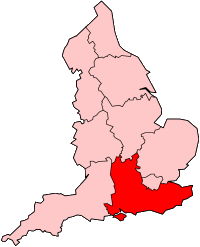Shepperton Branch Line
| Shepperton Branch Line | |
|---|---|
| Overview | |
| Type | Commuter rail, Heavy rail |
| System | National Rail |
| Status | Operational |
| Locale |
Greater London South East England |
| Termini |
London Waterloo Kingston Shepperton |
| Stations | 6 |
| Services | 1 |
| Operation | |
| Opened | 1 November 1864 |
| Owner | Network Rail |
| Operator(s) | South West Trains |
| Depot(s) | Wimbledon |
| Rolling stock |
Class 455 Class 450 |
| Technical | |
| Number of tracks | 2 |
| Track gauge | 1,435 mm (4 ft 8 1⁄2 in) standard gauge |
| Electrification | 750 V DC third rail |
| Operating speed | 60 mph (97 km/h) |
| Shepperton Branch Line | ||||||||||||||||||||||||||||||||||||||||||||||||||||||||||||||||||||||||||||||||||||||
|---|---|---|---|---|---|---|---|---|---|---|---|---|---|---|---|---|---|---|---|---|---|---|---|---|---|---|---|---|---|---|---|---|---|---|---|---|---|---|---|---|---|---|---|---|---|---|---|---|---|---|---|---|---|---|---|---|---|---|---|---|---|---|---|---|---|---|---|---|---|---|---|---|---|---|---|---|---|---|---|---|---|---|---|---|---|---|
Legend | ||||||||||||||||||||||||||||||||||||||||||||||||||||||||||||||||||||||||||||||||||||||
| ||||||||||||||||||||||||||||||||||||||||||||||||||||||||||||||||||||||||||||||||||||||
The Shepperton Branch Line is a railway line in the south west of London and north Surrey. It is also known as the Shepperton Line and connects to the Kingston Loop by a triangular junction between Strawberry Hill and Teddington stations.
History
The line opened on 1 November 1864 briefly named The Thames Valley Railway with access only from the Twickenham direction. The line was originally intended to reach a terminus on the north bank of the River Thames immediately east of Chertsey Bridge and the town itself but this plan was abandoned in 1862.[1] The line's optional curve linking Fulwell and Teddington initially opened only to freight on 1 July 1894 and first carried passengers on 1 June 1901. The line was electrified by the L&SWR using 630v DC third rail on 30 January 1916.
'Even the railway is a quite retiring type of line, ending abruptly at Shepperton, which is not in the way of being a metropolis; and so for many years a single train ran quietly to and fro upon a single line, resting a good deal and never hastening. And it is still in this state...till the racing tap is turned on every month or so.'
Demand and population in the area increased after the railway's relatively late introduction. Hampton station is the line's busiest with more than 1.2 million journeys made in the 2014-2015 financial year[3] Its recorded use was 0.7 million ten years before.[3] The total of journeys per year of the six stations on the line has reached 2.848 million recorded journeys. Hampton station has formally been assigned C2 (Important feeder) status as its station category.
Stations
Stations on the line are:
Services
Service on the line is half-hourly to London Waterloo via Kingston (hourly on Sundays).[4] Monday to Friday, four additional early morning rush-hour trains to Waterloo are routed via Twickenham and Richmond. Three additional evening rush-hour trains from Waterloo arrive via that route.[4]
In common with the 16 hourly off-peak closer commuter services to/from London Waterloo,[5] trains must stop at every intermediate station. There are no mid-track destination Waterloo to inner suburban services such as to Wimbledon or Kingston despite sidings there, which due to the long travel time gives overcapacity at Shepperton and overcrowding during the inner city phase of peak-hour journeys.[6] This situation can be contrasted to many other routes to destinations just outside Greater London.[7]
References
- ↑ London's Local Railways by Alan A. Jackson, Capital Transport (1999); ISBN 1-85414-209-7
- ↑ Charles Dickens, Jr.| All the Year Round Volume: 60 p.582.
- 1 2 "Station usage estimates". Rail statistics. Office of Rail Regulation.
- 1 2
- ↑ Calling at Earlsfield railway station and all intermediate London stations all managed by South West Trains, namely:
- 4tph to Guildford (2 via Cobham and 2 via Epsom) (excluding the fastest Portsmouth service)
- 2tph to Chessington South
- 2tph to Dorking
- 2tph to Hampton Court
- 2tph to Shepperton
- 2tph to Woking
- 2tph to Waterloo on the Kingston Loop
- ↑ "10-car SWT hangs in balance". Modern Railways (London): p. 52. December 2010.
- ↑ e.g. New Southern Railway's Tonbridge, Reigate and East Grinstead services which until leaving London only call at Clapham Junction and at East Croydon.
- Mitchell, Vic & Smith, Keith (1990). London Suburban Railways: Kingston and Hounslow Loops. Middleton Press.

